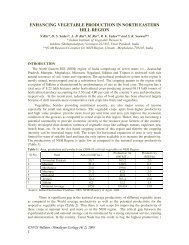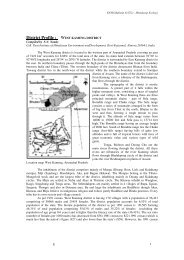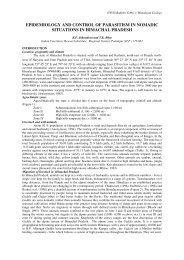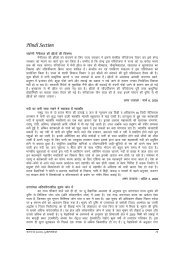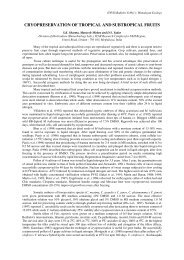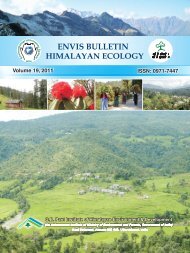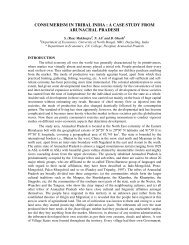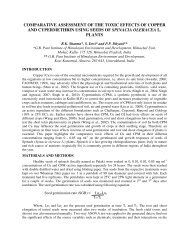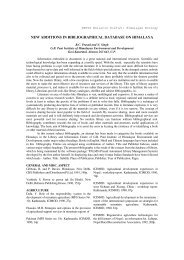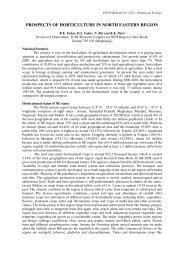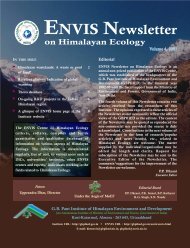IS GOAT FARMING A THREAT TO ECOLOGY?Sanjay Kumar 1 and Mahesh Chander 2Indian Veterinary Research Institute, Campus MukteswarKuma<strong>on</strong>, Nanital – 263138 (Uttaranchal) IndiaPresent address: 1 Scientist (SS), Agricultural Ec<strong>on</strong>omics, ARIS-Cell, IVRI, Izatnagar-2431222 Senior Scientist, Divisi<strong>on</strong> of Extensi<strong>on</strong> Educati<strong>on</strong>, IVRI, Izatnagar - 243122INTRODUCTIONGoat popularly known as poor man’s cow is widely distributed and clearly associated withpoor people, their ec<strong>on</strong>omic c<strong>on</strong>tributi<strong>on</strong> is extremely important for the security and livelihood ofthese people throughout the developing countries. This c<strong>on</strong>tributi<strong>on</strong> is varied, and the importance isreflected in terms of revenue generati<strong>on</strong>, cash security and enhanced qualitative human nutriti<strong>on</strong>. Thec<strong>on</strong>tributi<strong>on</strong> of goat to all the above said is well documented (Devendra, 1992; Kumar and Singh;1992; Kumar et al.,1992; Naidu et al., 1991; Singh and Ram, 1987).A lot has been said about the goat farming vis-a-vis threat to ecology. There is enoughevidence that goat farming is not a threat to ecology (Acharya and Singh, 1992) The comparativedestructive behavior of goat, sheep and other livestock is studied by Shankarnarayana, 1985 and givenclean chit to the goat species. The role of goat in regenerati<strong>on</strong> of vegetati<strong>on</strong> is well documented(Sharma and Ogra, 1987; Harsh and Shankar Narayana, 1992). Further role of goat in c<strong>on</strong>trollingweeds and preventi<strong>on</strong> of forest fire is studied by Holgate (1980), Edward (1981), Holga (1984),Mitchel (1984), Kolars (1966). Lastly the Government of India in the year 1987 c<strong>on</strong>stituted a taskforce under the chairmanship of Prof. K.H. Rao <strong>on</strong>e of the leading ec<strong>on</strong>omist of India. This task forceobserved that there was no definite evidence to prove that goat posed threat to the ecology as wasgenerally believed. They further recommended that sheep and goat should not be categorized asanimals resp<strong>on</strong>sible for the destructi<strong>on</strong> of ecology.In spite of above evidence in favour of goat farming, there is still firm beliefs am<strong>on</strong>g theforest officials, administrative officers, people of financial instituti<strong>on</strong> and even with the veterinaryofficers who have a big role to play in the development of animal husbandry that goat is a threat toecology.The populati<strong>on</strong> of goats shows a rising trend globally with more increase (56%) in developingcountries than in developed countries (33%) during 1975-95. No other livestock species excepting pig(56% increase) has registered this much increase over the years in developing countries (Schillhornv<strong>on</strong> veen, 1999). This indicates the emerging importance of goat producti<strong>on</strong> globally. The statisticsalso indicates the c<strong>on</strong>centrati<strong>on</strong> of goats in marginal areas like mountainous regi<strong>on</strong>, rainfed dry landand deserts of developing countries. Notwithstanding a l<strong>on</strong>g debate <strong>on</strong> goats and envir<strong>on</strong>mental threat,the rising trends <strong>on</strong>ly indicate that the choice of majority is in favour of goats.Given the above background, this paper based <strong>on</strong> empirical studies d<strong>on</strong>e am<strong>on</strong>g farmers of<strong>Himalayan</strong> regi<strong>on</strong>, researchers, forest officials, bank officials, development administrators, andveterinary officers tries to explore the c<strong>on</strong>troversies associated with the goat husbandry.MATERIAL AND METHODSThe target group of resp<strong>on</strong>dents c<strong>on</strong>sisted farmers of <strong>Himalayan</strong> regi<strong>on</strong>, researchers fromvarious disciplines of animal science from Central Sheep and Wool Research Institute (CSWRI),Avikanagar, Central Institute of Research <strong>on</strong> Goat (CIRG), Mathura, Sher-e-Kashmir University ofAgriculture and Technology (SKUAST), Srinagar, Izatnagar campus and Palampur campus of IndianVeterinary Research Institute (IVRI), Forest officials of Kuma<strong>on</strong> range, Bank officers of Nainital andAlmora district of Kuma<strong>on</strong> Hills, Veterinary officers of Kuma<strong>on</strong> Divisi<strong>on</strong> and the development16E N V IS C entre, G B P IH E D
administrators of the Kuma<strong>on</strong> range. For this study a total of 100 farmers, 25 researchers, 25administrators, 10 forest officers 20 bankers and 25 veterinary officers were interviewed by eithermailed questi<strong>on</strong>naire or by pers<strong>on</strong>al interview. The results were analyzed and presented as below.RESULTS AND DISCUSSIONFarmers’ viewAll the farmers unanimously declared that goat rearing was a profitable enterprise. Accordingto them through goat they were earning a good amount of cash and it acted as a security. The surplusfamily labor was engaged for this purpose al<strong>on</strong>g with the kitchen waste. 76% of the farmers were ofthe opini<strong>on</strong> that the goat was not a threat to ecology. The rest of them who were thinking that it wasthreat to ecology, said that the regenerati<strong>on</strong> of commercial plants were slow after the grazing of theplants by goats <strong>on</strong>ly during the initial phases of the plants. When asked, if the goat could be stall fed,the 78% of them answered in affirmative. However, as most of the farmers used to graze their goats inthe nearby forest without any supplementary feeding, they expressed that it would be costly anddifficult in stall-feeding of the goats. 100% of the farmers agreed that the human factor(management/c<strong>on</strong>servati<strong>on</strong>) was more resp<strong>on</strong>sible for the present status of the ecology than theanimals particularly the goats. The farmers were aware about the carrying capacity of their area andthey themselves c<strong>on</strong>trolled the numbers of their animals which adequately relects a lot about thewisdom of our poor farmers. They further demanded their participati<strong>on</strong> in the <strong>on</strong> going developmentworks which were directly affecting their ecology like c<strong>on</strong>structi<strong>on</strong> of roads, building, and irrigati<strong>on</strong>structure in their area.Researchers’ viewHundred percent of the researchers were of the opini<strong>on</strong> that goat farming was a profitableenterprise for the entire regi<strong>on</strong>. No researcher agreed that goat was threat to ecology; however, theywere worried about the increasing number of the species that too of the poor breed. They emphasizedthe need for the upgradati<strong>on</strong> of the local breed by sutiable breeding technique. 28% of them believedthat goat keeping through stall feeding would be ec<strong>on</strong>omical and they recommended the stall feedingat least for the ecologically fragile regi<strong>on</strong> of the country. 100% of the researchers were of the viewthat human factor was more resp<strong>on</strong>sible for the down gradati<strong>on</strong> of the ecology and not the animals.Administrators’ viewA majority of the development administrators’ openi<strong>on</strong> regarding the profitability was sameas that of the farmers and the researchers. However, 30% of them said that goat was threat to theecology and in support to their hypothesis they said that deforestati<strong>on</strong> was <strong>on</strong>ly due to this speciesalthough it was their prec<strong>on</strong>ceived noti<strong>on</strong> without any evidence but they were at the helms of affairrelated to the inclusi<strong>on</strong> of goat in the rural development program of their area of influnce. 100% ofthem believed that the goat could be stall fed and 80% of them said that the stall fed goat farming wasec<strong>on</strong>omical. One very interesting observati<strong>on</strong> was that about 40% of them believed that human factorwas not that important for the ecological degradati<strong>on</strong>.Forest officers’ viewHere also all of them agreed that the goat farming was a profitable enterprise. Surprisingly60% of them said that goat was a threat to the ecology and in their support they said that goat reducedthe good quality fodder from the forest and the regenerati<strong>on</strong> of forest was affected by grazing d<strong>on</strong>e bythe goat. All of them advocated stall-feeding of the goat and 60% of them declared it as ec<strong>on</strong>omical.When asked if the goat should be banned most of them answered in affirmative and said that at leastfrom the area like Kuma<strong>on</strong> hills it should not be allowed as free grazing animals. 60% of themaccepted the c<strong>on</strong>tributi<strong>on</strong> of human factor in ecological damage.E N V IS B ulletin : H im alayan E cology 12(2), 2004 17
- Page 6 and 7: after year (Gosh, 1984). In North E
- Page 8 and 9: Future thrustThe followings are the
- Page 10 and 11: Table 1: State wise area and produc
- Page 12 and 13: Table 2: Performance of tomato vari
- Page 14 and 15: durable, about 5-6 times costlier,
- Page 18 and 19: Bank officers’ viewAll the bank o
- Page 20: FOREST FRAGMENTATION : A THREAT TO
- Page 23 and 24: (ii)(iii)(iv)Area insensitive speci
- Page 25 and 26: ability to nest in the matrix area
- Page 27 and 28: Management actionsLand management e
- Page 29 and 30: Laurance, W. F and Bierregaard, Jr.
- Page 31 and 32: Sample surveyThe present study is b
- Page 33 and 34: Agricultural sectorBiomass from agr
- Page 35 and 36: anches, roots and wood chips etc. D
- Page 37 and 38: GoI, 2001. Report of the Working Gr
- Page 39 and 40: over use and misuse of forests but
- Page 41 and 42: has ensured their survival in extre
- Page 43 and 44: Kar, A. 2004. Common wild vegetable
- Page 45 and 46: test sites at Shimla and Nahan usin
- Page 47 and 48: performance for drought tolerance)
- Page 49 and 50: een assigned to different preceding
- Page 51 and 52: of Himalayan Environment and Develo
- Page 53 and 54: (2%). Total protein content varied
- Page 55 and 56: wheat flour slurry) and 'Malera' (p
- Page 57 and 58: Uniyal, V.P. 2004. Butterflies of N
- Page 59 and 60: N ew s & V iew sNumber of leopards
- Page 61 and 62: also discourage them intake thes dr
- Page 63 and 64: and fauna, Sikkim is redited with h
- Page 65 and 66: i{kksa ij v/;;u fd, tk pqds gSA Hkw
- Page 67 and 68:
laLFkku caxykSj esa izksQslj fouksn
- Page 69 and 70:
aa/kku dh ikjEifjd iztkfr;ksa ds la
- Page 71 and 72:
aaQwyksyksaa dh ?kkVh% % ,d izLrkfo
- Page 73:
dVku dks viuh ewlyknkj tM+ksa ds dk



